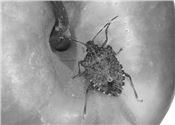|
Report Sightings Of Brown Marmorated Stink Bugs

The brown marmorated stink bug looks nearly identical to many stink bugs native to the South,
but the white-colored bands on their antennae set it apart. Originally found in the Northeast, these
insects damage fruit crops and invade homes and buildings in large numbers during the fall.
Submitted photo by MSU Extension Service
STARKVILLE, MISS.
Brown marmorated stink bugs took up residence in the Northeast nearly 20 years ago, but established populations of the destructive pest are now confirmed in the Southeast, including two reports in Mississippi.
Blake Layton, an entomology specialist with the Mississippi State University Extension Service, is asking homeowners and producers to report any sightings of the insect. These insects are on a different level than other stink bugs in the South because of the damage they cause in fruit and the issues they cause when they invade buildings, he said.
Both Mississippi sightings were reported three weeks ago near Tupelo, where hundreds of the stink bugs had invaded buildings 20 miles apart. The bugs’ physical features are similar to their Southern peers’, but there is one noticeable difference. Each antenna has two narrow, white-colored bands, producing a marbling, or marmorated, effect.
Layton said the white band nearest the tip of the antenna is usually more obvious than the other band.
“Brown marmorated stink bugs look a lot like many of our other brown stink bug species, and it would be easy for most folks to overlook them in a row-crop situation,” Layton said. “It makes sense that they would not have been reported in the Tupelo area until they started invading buildings.”
Each report indicated populations in the hundreds.
“In areas where they occur, they become serious household pests by invading homes and buildings in large numbers in the fall,” he said. “In the Northeast, thousands or more are often seen in one place. It’s not that a big of problem here yet, but enough to get our attention.”
Although several of these bugs have been found in the state every year in recent years, they previously failed to reproduce during the summer and establish larger populations.
“These were always bugs that had apparently been transported into the state on semi-trucks, RV campers and loads of furniture coming from the Northeast,” Layton said. “The two incidents occurred about two weeks ago and seemed to be associated with maturation and harvest of nearby soybean fields.”
The pests have not been found in soybean fields or any other crop in Mississippi so far.
“There are large soybean fields near each of these locations, so it is likely they came from soybeans,” he said. “In other states, these are serious new pests of apples and peaches, causing millions of dollars in losses when not controlled. They have a wide host range, including fruits, vegetables, row crops and even some ornamental plants.”
The first sighting of the insect in Mississippi was in 2007, when USDA entomologist Margaret Allen found small numbers of them near Cleveland feeding on pears in her yard. Thinking they were common brown stink bugs, she took them to her laboratory to examine them.
“When I set them up as a colony, it became obvious to me that they were not the local species, so I consulted with other entomologists to verify that they were brown marmorated stink bugs,” Allen said. “Sure enough, they were. I kept the colony alive for almost a year. Recognizing that I had found something new to the region, I searched for them during my outdoor activities, but never found more specimens.”
Layton said the best way to deal with infestations is with a vacuum or broom and dust pan. He does not recommend using insecticides to control them inside structures.
“Residual insecticide sprays on outdoor building surfaces where the bugs are congregating can be somewhat helpful if the label directions are followed,” he said. “The best defense is good, proactive insect exclusion. Make sure your houses and buildings are bug-tight before the insects get inside.” ∆
|
|